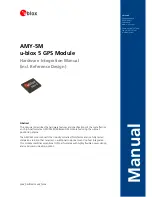
–
Extra safety wanted due to sensitive and/or
expensive equipment being connected to
the GPS timebase system.
A lightning arrestor should be mounted inside
the building close to the cable entry point.
Harsh environmental conditions
Snow and ice on the surface of the antenna can
significantly reduce the effective sensitivity by
as much as 6 dB. You could, for instance, utilize
an electrically heated radome to house the an-
tenna unit, to avoid the attenuation effects of
this environmental influence.
Other weather conditions having negative in-
fluence on the system sensitivity are heavy rain
and fog. The attenuation effects are normally
covered by the 3 dB guard band, used in the cal-
culations.
n
Four Practical Examples
Example 1
Requirements
Cable length:
Lightning arrester:
Climatic conditions:
52 m (5 m indoors)
yes
normal
Solution
The cable length indoors, i.e. after the lightning
arrester, must be at least 8 m, otherwise the pro-
tective function may not be guaranteed. So, you
have to make the cable 3 m longer indoors. The
effective cable length will be 55 m instead. This
is the upper limit for the standard RG-213 ca-
ble, under normal climatic conditions.
Calculation of total gain at the receiver input,
using a RG-213 cable with an attenuation of
0.40 dB/m (40 dB per 100 m), under
normal
environmental conditions
:
Antenna gain:
Cable loss:
Guard band:
Total gain:
+36 dB
-22 dB (-55 * 0.40)
-3 dB
+11 dB (36-22-3)
This gain figure is exactly at the lower permis-
sible level at the receiver input.
Example 2
Requirements
Cable length:
Lightning arrester:
Climatic conditions:
55 m (50 m indoors)
no
snow and ice
Solution
The cable length 55 m is the upper limit for the
standard RG-213 cable, under
normal environ-
mental conditions.
But snow and ice on the surface of the antenna
can attenuate the signal by 6 dB.
Let us calculate total gain at the receiver input
for a RG-213 cable, taking the snow and ice
factor into consideration:
Antenna gain:
Harsh weather:
Cable loss:
Guard band:
Total gain:
+36 dB
-6 dB
-22 dB (-55 * 0.40)
-3 dB
+5 dB (36-6-22-3)
The latter figure should be in the range 11 – 33
dB, so the additional 6 dB loss due to extreme
weather conditions requires the use of a
low-loss cable, e.g. LMR400, having an attenu-
ation of 0.17 dB/m (17 dB per 100m). This
gives the following total gain:
8-5 Antenna Installation
Appendix
Summary of Contents for GPS-12
Page 1: ...GPS 12 GPS 12R GPS 12R HS GPS 12RG GPS GLONASS GPS Frequency Standards User s Manual...
Page 2: ...II 4031 600 12001 Rev 05 May 2017 2017 Pendulum Instruments Altaria Services...
Page 5: ...Chapter 1 Preface...
Page 8: ...This page is intentionally left blank 1 4 Preface...
Page 9: ...Chapter 2 Preparation for Use...
Page 17: ...Chapter 3 Using the Controls...
Page 24: ...This page is intentionally left blank 3 8 User Interface Using the Controls...
Page 25: ...Chapter 4 GPS 12 Monitor...
Page 28: ...This page is intentionally left blank 4 4 Main Features GPS 12 Monitor...
Page 29: ...Chapter 5 Performance Check...
Page 35: ...Chapter 6 Preventive Maintenance...
Page 38: ...This page is intentionally left blank 6 4 Battery Replacement Preventive Maintenance...
Page 39: ...Chapter 7 Specifications...
Page 48: ...This page is intentionally left blank 7 10 Ordering Information Specifications...
Page 49: ...Chapter 8 Appendix...
Page 57: ...Chapter 9 Index...
Page 61: ...Chapter 10 Service...










































